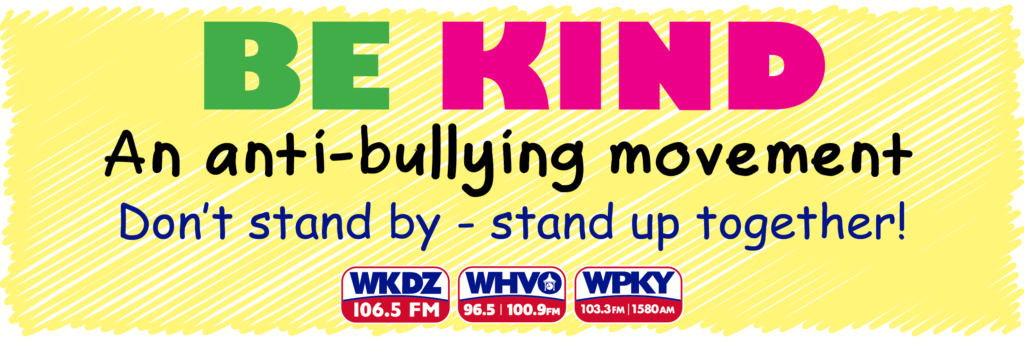Brought to you by HB Quinn Attorney & Trigg County Schools
About the BE KIND Movement
At The Edge Media Group, we believe it is time for change. Whether you are a parent, guardian, teacher, family member or friend, knowing the signs that a child is being bullied or is participating in bullying others, is critical!! We hope this resource page will help you recognize the signs of either scenario, and what to do to help your child.
Don’t stand by – stand up together! And above all…BE KIND!
Forms of Bullying
Bullying has many forms from physical (pushing, punching, or hitting); verbal (name-calling or threats); or psychological and emotional (spreading rumors or excluding someone from a conversation or activity). With today’s modern technology, inappropriate behavior between kids can occur through social media, emails and text messages. This is called cyberbullying. For many school-aged kids (particularly middle and high school age), even going home doesn’t provide a safe space and escape from the harmful effects of bullying. Some cyberbullying even crosses the line into unlawful or criminal behavior.
The most common places where cyberbullying occurs are:
- Social Media, such as Facebook, Instagram, Snapchat, and Tik Tok
- Text messaging and messaging apps on mobile or tablet devices
- Instant messaging, direct messaging, and online chatting over the internet
- Online forums, chat rooms, and message boards, such as Reddit
- Online gaming communities
The statistics say it all!
The statistics are truly staggering. The National Center for Educational Statistics 2019 reported that one out of every five students report being bullied. The reasons for being bullied reported most often by students include physical appearance, race/ethnicity, gender, disability, religion and sexual orientation. Among students ages 12 – 18 who reported being bullied at school, 15% were bullied online or by text. In fact, the percentages of individuals who have experienced cyberbullying at some point in their lifetimes have more than doubled (18% to 37%) from 2007-2019. Students who experience bullying are at increased risk for depression, anxiety, sleep difficulties, lower academic achievement, and dropping out of school. Students who report frequently bullying others and students who report being frequently bullied are at increased risk for suicide-related behavior. (https://www.pacer.org/bullying/info/stats.asp)
So why don’t kids ask for help?
It is estimated only 20% of school bullying incidents are reported. Kids don’t tell adults for many reasons:
- Bullying can make a child feel helpless. Kids may want to handle it on their own to feel in control again. They may fear being seen as weak or a tattletale.
- Kids may fear backlash from the kid who bullied them.
- Bullying can be a humiliating experience. Kids may not want adults to know what is being said about them, whether true or false. They may also fear that adults will judge them or punish them for being weak.
- Kids who are bullied may already feel socially isolated. They may feel like no one cares or could understand.
- Kids may fear being rejected by their peers. Friends can help protect kids from bullying, and kids can fear losing this support.
Signs that may point to a bullying problem are:
- Unexplainable injuries
- Lost or destroyed clothing, books, electronics, or jewelry
- Frequent headaches or stomach aches feeling sick or faking an illness
- Changes in eating habits, like suddenly skipping meals or binge eating. Kids may come home from school hungry because they did not eat lunch.
- Difficulty sleeping or frequent nightmares
- Declining grades, loss of interest in schoolwork, or not wanting to go to school
- Sudden loss of friends or avoidance of social situations
- Feelings of helplessness or decreased self esteem
- Self-destructive behaviors such as running away from home, harming themselves, or talking about suicide
Signs that may point to cyberbullying are:
- They stop using the computer without explanation
- They appear nervous or jumpy when getting an instant message or email
- They are uneasy about going out or going to school
- They are secretive about what they are doing on the computer
- They appear angry or depressed after using the computer
- They are abnormally withdrawn from friends and family
If you know someone in serious distress or danger, don’t ignore the problem. GET HELP RIGHT AWAY!.
Kids may be bullying others if they:
- Get into physical or verbal fights
- Have friends who bully others
- Are increasingly aggressive
- Get sent to the principal’s office or to detention frequently
- Have unexplained extra money or new belongings
- Blame others for their problems
- Don’t accept responsibility for their actions
- Are competitive and worry about their reputation or popularity
Here are some tips on how to help your child if they are being bullied…
Take Action to Stop Bullying
Ultimately, it’s up to parents or guardians to help your children deal with a bully. Help them learn how to make smart choices and take action when they feel hurt or see another child being bullied, and be ready to intervene if necessary.
Report repeated, severe bullying
If your child is reluctant to report the bullying, go with them to talk to a teacher, guidance counselor, principal, or school administrator. When necessary, get help from others outside of school, like a family therapist or a police officer, and take advantage of community resources we have listed below that can deal with and stop bullying.
Encourage your child to be an upstander
Being an upstander (and not a passive bystander) means a child takes positive action when they see a friend or another student being bullied. When it’s the kids who speak up, it’s more powerful than anything that an adult can do.







